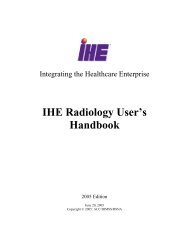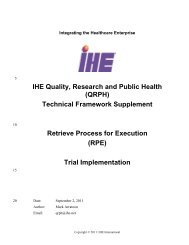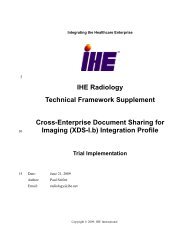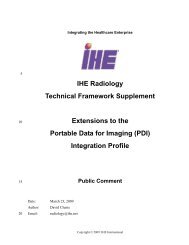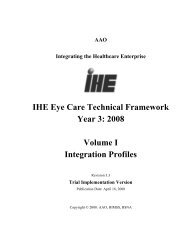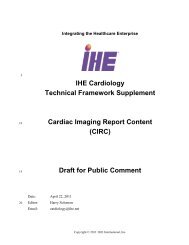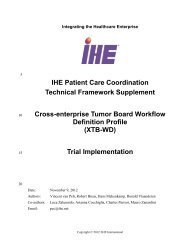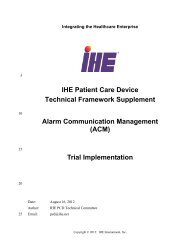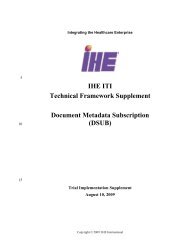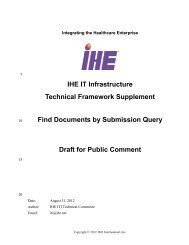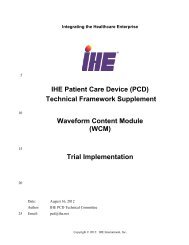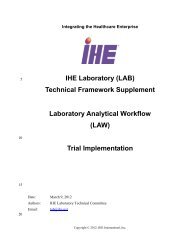IHE Patient Care Device Technical Framework
IHE Patient Care Device Technical Framework
IHE Patient Care Device Technical Framework
- No tags were found...
You also want an ePaper? Increase the reach of your titles
YUMPU automatically turns print PDFs into web optimized ePapers that Google loves.
<strong>IHE</strong> <strong>Patient</strong> <strong>Care</strong> <strong>Device</strong> <strong>Technical</strong> <strong>Framework</strong>, Vol. 2: Transactions________________________________________________________________________The appendices following the main body of this volume provide technical detailsassociated with the transactions.1.3 AudienceThe intended audience of this document is:• IT departments of healthcare institutions• <strong>Technical</strong> staff of vendors planning to participate in the <strong>IHE</strong> initiative• Experts involved in standards development• Those interested in integrating healthcare information systems and workflows1.4 Relationship to Standards102030The <strong>IHE</strong> <strong>Technical</strong> <strong>Framework</strong> identifies functional components of a distributedhealthcare environment (referred to as <strong>IHE</strong> actors), solely from the point of view of theirinteractions in the healthcare enterprise. At its current level of development, it defines acoordinated set of transactions based on ASTM, DICOM, HL7, IEEE, IETF, ISO, OASISand W3C standards. As the scope of the <strong>IHE</strong> initiative expands, transactions based onother standards may be included as required.In some cases, <strong>IHE</strong> recommends selection of specific options supported by thesestandards; however, <strong>IHE</strong> does not introduce technical choices that contradictconformance to these standards. If errors in or extensions to existing standards areidentified, <strong>IHE</strong>’s policy is to report them to the appropriate standards bodies forresolution within their conformance and standards evolution strategy.<strong>IHE</strong> is therefore an implementation framework, not a standard. Conformance claims forproducts must still be made in direct reference to specific standards. In addition, vendorswho have implemented <strong>IHE</strong> integration capabilities in their products may publish <strong>IHE</strong>Integration Statements to communicate their products’ capabilities. Vendors publishing<strong>IHE</strong> Integration Statements accept full responsibility for their content. By comparing the<strong>IHE</strong> Integration Statements from different products, a user familiar with the <strong>IHE</strong> conceptsof actors and integration profiles can determine the level of integration between them.See Appendix H for the format of <strong>IHE</strong> PCD Integration Statements. <strong>IHE</strong> encouragesimplementers to ensure that products implemented in accordance with the <strong>IHE</strong> <strong>Technical</strong><strong>Framework</strong> also meet the full requirements of the standards underlying <strong>IHE</strong>, allowing theproducts to interact, although possibly at a lower level of integration, with products thathave been implemented in conformance with those standards, but not in full accordancewith the <strong>IHE</strong> <strong>Technical</strong> <strong>Framework</strong>.Rev. 1.1 TI: 2006-08-157Copyright © 2005-2006: ACC, ACCE, HIMSS, and RSNA



